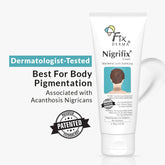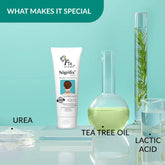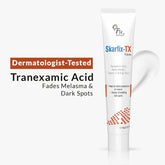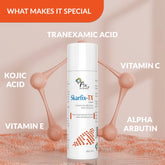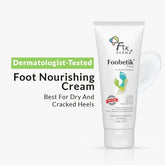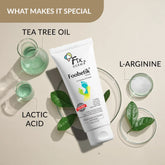Hydration vs. Humidity: Why Your Skin Needs Moisturizer During Monsoon Season

Table of Content
It’s a question we all ask during the rainy season: If the air feels so moist and sticky, why does my skin still feel dry, patchy, or tight? The monsoon season plays tricks on our skin. Between sudden downpours, unexpected humidity, and indoor air conditioning, your skin gets pulled in multiple directions. It might feel greasy on the outside, but parched from within, especially if you have oily or acne-prone skin. That’s where the confusion begins.
Here’s the truth: Humidity in the air doesn’t mean your skin is hydrated. In fact, humidity can disrupt your skin’s barrier and lead to more dehydration if you're not careful.
Let’s decode what your skin really needs this monsoon.

Humidity Vs. Hydration
When humidity levels rise, your skin responds by sweating more and producing more oil. This is your skin's way of protecting itself, but unfortunately, it also means clogged pores, stickiness, and acne flare-ups, especially for oily and acne-prone skin.
What you don’t see is that this process dehydrates your skin from within. The water content in your skin evaporates quickly in such weather, leaving it uncomfortably tight or patchy in certain areas. That’s why people often complain of oily skin that still looks dull or feels sensitive.
The solution is simply to restore your skin’s moisture balance with a best hydrating moisturizer so your skin doesn’t have to overcompensate with excess oil. Humidity makes your skin sweat more, which gives a temporary illusion of plump, dewy skin.
But here’s what’s really happening underneath:
- Sweat evaporates quickly, taking your skin's natural moisture with it.
- Sebum production increases, especially if you have oily or combination skin.
- Your skin barrier weakens, making it harder to retain water.
- Air-conditioned rooms and hot showers strip away moisture even faster.
This is why skipping your moisturizer during monsoon can backfire, leading to dullness, flakiness, and even more oil production.

What Happens When You Skip Moisturizer in Monsoon?
Here’s how your skin might respond if you ditch moisturizer during the rainy season:
- Increased oiliness: Your skin goes into overdrive to compensate for lost moisture.
- Clogged pores & acne: Excess oil + sweat + pollution = congestion.
- Dehydrated skin: Tight, rough, and flaky patches, especially around the cheeks and nose.
- Impaired skin barrier: Makes your skin more vulnerable to infections, breakouts, and sensitivity.
Bonus Tip: A lightweight, non-comedogenic moisturizer is crucial during the monsoon, even for oily skin types. It helps your skin stay balanced, hydrated, and protected from environmental damage.

Why Moisturizing is a Must (Even for Oily & Acne-Prone Skin)
Moisturizers aren’t just for dry skin. In fact, skipping moisturizer is one of the biggest mistakes people with oily or acne-prone skin make during monsoon.
Here’s why you need it:
-
Hydration keeps oil in check: Balanced skin = less sebum production.
-
Moisturizers support your barrier: They lock in water and block environmental irritants.
-
Right formulas can fight acne: Some moisturizers now include active ingredients that also treat breakouts.
-
Preps skin for actives: Helps prevent irritation when using exfoliants, salicylic acid, or acne treatments.

Best Moisturizers for Monsoon Season Recommended by Dermatologists
When choosing a best moisturizer for dry skin in monsoon, look for:
- Oil-free or non-comedogenic formulas
- Gel-based or lightweight creams
- Ingredients like hyaluronic acid, niacinamide, panthenol, and ceramides
- Fragrance-free or gentle actives if you have sensitive skin
Avoid thick, greasy creams that can clog pores and feel heavy in humidity.

Fixderma’s Expert-Backed Best Moisturizer For All Season
Fixderma has clinically backed solutions designed specifically for acne-prone, oily, and sensitive skin, even during tricky seasons like monsoon. It hydrates without clogging pores and helps reduce redness, breakouts, and inflammation. Trusted by dermatologists across India for skin that’s struggling with oil and humidity. Here are the best moisturizer recommended according to different skin type:
Best Moisturizer for Oily, Acne-Prone Skin
-
Use a non-comedogenic moisturizer like Skarfix-TX Cream. Apply it after cleansing and acne treatments to seal in hydration for your skin. It hydrates without clogging the pores or causing future flare ups.
Best Moisturizer For Dry Skin
-
Look for a rich, hydrating face moisturizer like the Cleovera Cica Cream that nourishes dry skin without any greasiness. Reapply as needed, especially after using a face wash to hydrate your skin during the humid season.
Best Moisturizer For Combination Skin
-
Look for oil-free moisturizers like the Tomaglow Brightening Cream that deeply hydrates your skin without any shine. Apply more in dry areas (cheeks) and less in oily zones (T-zone).
Best Moisturizer For Sensitive Skin
-
Pick fragrance-free, alcohol-free formulas like Cleovera Cica Cream that locks in moisture and strengthens your skin barrier. Do a patch test before using any new moisturizer.
How to Use Moisturizer in Your Monsoon Skincare Routine
A good skincare routine gives better results. Here’s how to slot moisturizer into your day:
Morning Skincare Routine:
- Cleanse with a gentle face wash like Fixderma Dewrav Gentle & Hydrating Face Wash.
- Apply a treatment serum or gel for a targeted skin concern like Pore Minimizing Face Serum to refine the size of open pores.
- Apply a lightweight, oil-free moisturizer for acne prone skin like Fixderma Tomaglow Brightening Cream for radiant, glowing skin.
- Follow this with a gel-based, lightweight sunscreen with SPF 50+ like Fixderma Shadow Brightening Cream SPF 50+ Sunscreen
Night Skincare Routine:
- Cleanse with Tomaglow Brightening Cleanser at night to remove dirt, sweat and sunscreen.
- Use your nighttime acne treatment or a face serum to target acne marks, dark spots and pigmentation like Tomaglow Brightening Face Serum.
- Seal it all in with Tomaglow Brightening Cream. Always apply moisturizer on slightly damp skin, it helps lock in water better.
Final Takeaway
Humidity may make your skin sweat, but it doesn’t hydrate. In fact, the monsoon season can dry out your skin in sneaky ways, leaving it oily, unbalanced, and prone to breakouts. That’s why using the right moisturizer is not optional, it’s an absolute necessity.
Whether your skin is oily, acne-prone, or dry, Fixderma’s clinically designed moisturizers help restore balance, reduce breakouts, and strengthen your barrier through all seasons.
Frequently Asked Questions
-
Which Fixderma moisturizer is best for oily, acne-prone skin in monsoon?
Fixderma Tomaglow Brightening Cream is perfect for oily and acne-prone skin during the monsoon. It offers lightweight hydration, controls excess oil, and is non-comedogenic, so it won’t clog pores or trigger breakouts.
-
What type of moisturizer is best for humid weather?
For humid weather, go for gel-based or water-based moisturizers that are lightweight, non-greasy, and non-comedogenic.
-
What makes Fixderma moisturizers suitable for monsoon skin issues?
Fixderma moisturizers are formulated with clinically backed ingredients like hyaluronic acid, ceramides, niacinamide, and peptides. These help hydrate, repair the skin barrier, and reduce acne or sensitivity caused by monsoon humidity.
-
Is Fixderma cream good for dry skin during monsoon?
Absolutely. Fixderma Skarfix TX cream is designed to reduce hyperpigmentation. It hydrates the skin without feeling heavy on the skin in humid weather.
-
How do I include Fixderma moisturizer in my monsoon skincare routine?
Cleanse your face with a gentle face wash, apply any treatment serum, and follow up with a suitable Fixderma Cleovera Cica Cream. Use it morning and night to keep your skin balanced, hydrated, and breakout-free.
